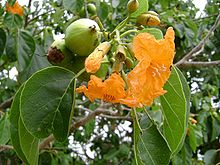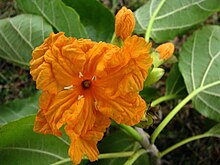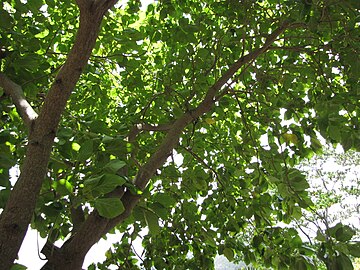| Cordia subcordata | |
|---|---|

| |
| Flower and fruit | |
|
Scientific classification
| |
| Kingdom: | Plantae |
| Clade: | Tracheophytes |
| Clade: | Angiosperms |
| Clade: | Eudicots |
| Clade: | Asterids |
| Order: | Boraginales |
| Family: | Boraginaceae |
| Genus: | Cordia |
| Species: | C. subcordata
|
| Binomial name | |
| Cordia subcordata | |
| Synonyms [3] | |
|
List
| |
Cordia subcordata is a species of flowering tree in the borage family, [3] it can be found growing in eastern Africa, South Asia, Southeast Asia, northern Australia and the Pacific Islands including Hawaii. [2] The plant is known by a variety of names including kou, [4] beach cordia, sea trumpet, and kerosene wood, among others.
Names
Other names for the species include kanawa, tou, mareer, manjak, snottygobbles, glueberry, narrow-leafed bird lime tree, In Java and Madura, it is known as kalimasada, purnamasada, or pramasada; Javanese folklore consider the tree to contain spiritual power. [5] In the Marshall Islands it is known as kono. [6] In Fiji, it is called nawanawa. [7]
Distribution
This species has a very wide range from the east coast of Africa west throughout tropical Asia and Oceania, as far west as Hawaii. This distribution was achieved due to special characteristics of its fruit allowing for successful oceanic dispersal. [8] Prior to 2001, C. subcordata was considered to be a Polynesian introduction to Hawaii by many authorities, but subfossil evidence from Makauwahi Cave in Kauai indicates that it was an abundant species in Hawaiian lowland forests well before humans arrived, confirming its status as an indigenous species. [9]
Description
C. subcordata or kou trees are found in coasts at elevations from sea level to 30 m (98 ft) that receive 1,000–4,000 mm (39–157 in) of annual rainfall. They prefer neutral to alkaline soils ( pH of 6.1 to 7.4), such as those originating from basalt, limestone, clay, or sand. Allowable soil textures include sand, sandy loam, loam, sandy clay loam, sandy clay, clay loam, and clay. [4] It can also grow in edges of rocky shores and mangrove swamps. [7]
A mature kou tree grows to 7–10 m (23–33 ft) at maturity, but may be as tall as 15 m (49 ft). It has ovate leaves that are 8–20 cm (3.1–7.9 in) and 5–13 cm (2.0–5.1 in) wide and short hairs on their upper surface. [4] [10]: 78
Flowers and fruit

Blooming occurs throughout the year, but most kou flowers are produced in the spring.[ when?] [11] Each kou flower is funnel or tube-shaped 1–2 cm (0.39–0.79 in) long and 0.4–0.8 cm (0.16–0.31 in) in diameter made of orange petals and pale green sepals that form cymes or panicles. [4] [10]: 78
Kou trees produce fruit all year around. Their fruit are spherical 2–3 cm (0.79–1.18 in) long, brown, and woody when mature. Each fruit contains four or fewer seeds that are 10–13 mm (0.39–0.51 in) long. The fruit are buoyant and may be carried very far by ocean currents. [4]
Uses
The seeds are edible and have been eaten during famine. [4]
The wood of the tree has a specific gravity of 0.45, is soft, durable, easily worked, [11] and resistant to termites. In ancient Hawaiʻi kou wood was used to make ʻumeke (bowls), utensils, and ʻumeke lāʻau (large calabashes) because it did not impart a foul taste to food. ʻUmeke lāʻau were 8–16 litres (2–4 gal) and used to store and ferment poi. Kou wood burns readily as firewood, and this led to the nickname of "Kerosene Tree" in Papua New Guinea. [4] The flowers were used to make lei, while a dye for kapa cloth and aho ( fishing lines) was derived from the leaves. [4] Fijians obtain fibre to make baskets and garlands from its inner bark by soaking it in seawater. [7]
In the western Solomon Islands, in Vanuatu, on Waya Island, and in Tonga, it is used for carving. On New Ireland, its wood is always used for the ceremonial entrances to men's houses. [12]
Threats
Despite its very wide distribution, this species faces threats in parts of its range. During the mid-late 19th century, herbivory by the kou moth ( Ethmia nigroapicella) nearly extirpated this species on the Hawaiian Islands. [13] It is thought to be highly endangered in Sri Lanka, only persisting at a small number of sites that are under pressure from development. [8] Logging of mature trees to create carvings for the tourism industry is also thought to be a threat throughout much of Papuasia. In addition, it may potentially be threatened by storms and sea level rise. [1]
See also
References
- ^ a b Oldfield, S. (2019). "Cordia subcordata". IUCN Red List of Threatened Species. 2019: e.T33199A67739216. doi: 10.2305/IUCN.UK.2019-2.RLTS.T33199A67739216.en. Retrieved 19 November 2021.
- ^ a b "Cordia subcordata". Germplasm Resources Information Network. Agricultural Research Service, United States Department of Agriculture. Retrieved 2 March 2010.
- ^ a b "Cordia subcordata Lam". Plants of the World Online. Royal Botanic Gardens, Kew. 2023. Retrieved 26 September 2023.
- ^ a b c d e f g h Friday, J. B.; Okano, Dana (April 2006). "Cordia subcordata (kou)" (PDF). Species Profiles for Pacific Island Agroforestry. The Traditional Tree Initiative. Archived (PDF) from the original on 16 January 2009. Retrieved 21 September 2009.
- ^ Bosbouwproefstation (1936). Korte mededeelingen – Cordia Subcordata. Cornell University. p. 107. Archived from the original on 31 July 2021. Retrieved 30 May 2015.
- ^ "Native plants of the Marshalls". Republic of the Marshall Islands Biodiversity Clearing House Mechanism. RMI Office of Environmental Planning and Policy Coordination. 2 October 2008. Archived from the original on 19 June 2015. Retrieved 7 September 2019.
- ^ a b c Keppel, Gunnar; Ghazanfar, Shahina A. (2011). Trees of Fiji: A Guide to 100 Rainforest Trees (third, revised ed.). Secretariat of the Pacific Community & Deutsche Gesellschaft für Technische Zusammenarbeit. pp. 62–3.
- ^ a b Jayasuriya, A. H. Magdon; Gunatilleke, I. A. U. Nimal (18 September 2015). "A refugium for Cordia subcordata (Boraginaceae), a very rare and endangered plant in Sri Lanka and strategies for its conservation". Ceylon Journal of Science (Biological Sciences). 44 (1): 67. doi: 10.4038/cjsbs.v44i1.7343. ISSN 0069-2379.
- ^ Burney, David A.; James, Helen F.; Burney, Lida Pigott; Olson, Storrs L.; Kikuchi, William; Wagner, Warren L.; Burney, Mara; McCloskey, Deirdre; Kikuchi, Delores; Grady, Frederick V.; Gage, Reginald (November 2001). "Fossil Evidence for a Diverse Biota from Kaua'i and its Transformation Since Human Arrival". Ecological Monographs. 71 (4): 615–641. doi: 10.1890/0012-9615(2001)071[0615:FEFADB]2.0.CO;2. ISSN 0012-9615.
- ^ a b Riedl, H. (1997). "Boraginaceae". Flora Malesiana. 13 (1): 43–144 – via Naturalis Institutional Repository.
- ^ a b Allen, James A. (1 January 2003). "Cordia subcordata Lam". Tropical Tree Seed Manual. Reforestation, Nurseries & Genetics Resources. Archived from the original on 16 January 2009. Retrieved 24 February 2009.
- ^ Pawley, Andrew; Osmond, Meredith (eds). 2008. The lexicon of Proto Oceanic: The culture and environment of ancestral Oceanic society Archived 31 July 2021 at the Wayback Machine. Volume 3: Plants Archived 4 February 2019 at the Wayback Machine. Pacific Linguistics 599. Canberra: Pacific Linguistics, Australian National University.
- ^ Swezey, OH (1944). "The Kou Moth, Ethmia colonella Walsm., in Hawaii" (PDF). Hawaiian Entomological Society.
External links
![]() Media related to
Cordia subcordata at Wikimedia Commons
Media related to
Cordia subcordata at Wikimedia Commons
![]() Data related to
Cordia subcordata at Wikispecies
Data related to
Cordia subcordata at Wikispecies
- "Cordia subcordata". FloraBase. Western Australian Government Department of Biodiversity, Conservation and Attractions.
- IUCN Red List least concern species
- Cordia
- Plants described in 1792
- Asterids of Australia
- Eudicots of Western Australia
- Flora of Ashmore and Cartier Islands
- Flora of the Coral Sea Islands Territory
- Flora of Kenya
- Flora of Madagascar
- Flora of Mozambique
- Flora of the Northern Territory
- Flora of Queensland
- Flora of Somalia
- Flora of Tanzania
- Flora of tropical Asia
- Least concern flora of Australia
- Least concern biota of Queensland
- Trees of Australia
- Trees of the Pacific
- Flora of Tonga



